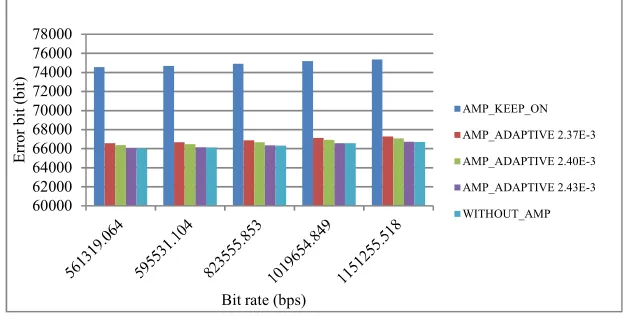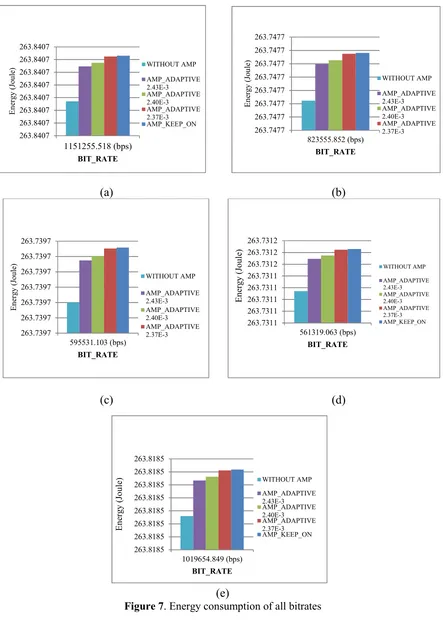IOP Conference Series: Materials Science and Engineering
PAPER • OPEN ACCESS
Energy-signal quality trade-offs in a WiMAX mobile
station with a booster amplifier
To cite this article: Suherman et al 2018 IOP Conf. Ser.: Mater. Sci. Eng.309 012003
View the article online for updates and enhancements.
Related content
A novel printed small antenna with L-shaped structure for multiband applications
B. Heydarpanah, C. Ghobadi, J. Nourinia et al.
-Energy consumption model on WiMAX subscriber station
N Mubarakah, Suherman, M Y Al-Hakim et al.
-Accurate measurement of RF exposure from emerging wireless communication systems
Thierry Letertre, Vikass Monebhurrun and Zeno Toffano
1234567890‘’“”
TALENTA-CEST 2017 IOP Publishing
IOP Conf. Series: Materials Science and Engineering 309 (2018) 012003 doi:10.1088/1757-899X/309/1/012003
Energy-signal quality trade-offs in a WiMAX mobile station
with a booster amplifier
Suherman*,N Mubarakah, O Wiranata, S T Kasim
Electrical Engineering Department, Universitas Sumatera Utara, Indonesia
*E-mail: suherman@usu.ac.id
Abstract. Worldwide Interoperability for Microwave Access (WiMAX) is a broadband wireless access technology that is able to provide high bit rate mobile internet services. Battery endurance remains a problem in current mobile communication. On the other hand, signal quality determines the successful run of the mobile applications. Energy consumption optimization cannot sacrifice the signal level required by the application to run smoothly. On the contrary, the application should consider battery life time. This paper examines the trade-offs between energy and signal quality in WiMAX subscriber station by adjusting signal level using a booster amplifier. Simulation evaluations show that an increment of 0.00000104% energy consumption on using amplifier adaptively produces 16.411% signal to noise ratio (SNR) increment and 10.7% bit error rate (BER) decrement. By keeping the amplifier turned on, energy consumption increases up to 0.00000136%, causing the SNR rises to 17.2638% and BER drops to 11.13%. The evaluated application is video streaming, other application may behave differently.
1. Introduction
Worldwide Interoperability for Microwave Access (WiMAX) is a Broadband Wireless Access (BWA) technology with a wide coverage area standardized by the IEEE 802.16 [1]. WiMAX was initially set for fixed wireless broadband services dominated by point to point configuration on 10-66 Ghz frequency band. In order to enhance its bandwidth, but handover and roaming procedures addition enable WiMAX serving mobile users [2].
2
1234567890‘’“”
TALENTA-CEST 2017 IOP Publishing
IOP Conf. Series: Materials Science and Engineering 309 (2018) 012003 doi:10.1088/1757-899X/309/1/012003
Figure 1. WiMAX Frame Structure [3]
WiMAX supports the multimedia network requirements. Multimedia packet receptions are depending upon the signal strength transmitted by the BS and received by the SS. Moreover if SS is in moving position, propagation media and obstacles influence the received signal very much. Indoor and outdoor changes cause signal variations that may generate packet loss. Amplifying signal at the receiver means increasing signal to noise ratio as well as energy consumption. Increasing signal to noise ratio improves the probability bit detection, improving the performance. However, increasing energy consumed by the amplifier means draining the battery faster. This paper assessed the trade-off between signal amplification and energy consumption on the simulated WiMAX network. Although this simulation does not necessary reflect the real implementation, the idea may be explored further in application environment.
2. Research method
In order to evaluate the trade-off between signal amplification at the receiver and receiver energy consumption, NS-2 simulator is employed. NS-2 is an event-based simulator that is flexible to make changes to some networks and protocols [4]. Network condition is set to have 7Mbps bandwidth with 4 (four) subscriber station one is in a fixed position, (0 m/s); walking speed (1.39 m/s); cycling speed (4.44 m/s) and driving speed (6.67 m/s). WiMAX coverage has 1000 m diameter with 64 QAM and two-ray ground propagation. Network configuration is depicted in Figure 2.
Figure 2. Network configuration
1234567890‘’“”
TALENTA-CEST 2017 IOP Publishing
IOP Conf. Series: Materials Science and Engineering 309 (2018) 012003 doi:10.1088/1757-899X/309/1/012003
Operation Mode NS-2 state Normalized power consumption
On dl subframe While_dl_subframe 1.00
On ul subframe While_ul_subframe 1.00
On sleep mode while_sleep_mode 0.29
On idle mode while_idle_mode 0.06
Turned on while_turned_on 1.00
Transmitting ul burst while_ul_burst ratio 0.17
Transmitting ul burst while_ul_burst_energy ratio 0.01
Figure 3. WiMAX Normalized Power Consumption [5]
The signal amplification was realized by inserting amplifier model proposed by Kumar et al. [6]. The amplification is modelled by using mathematical equation as in Equation 1 [6]. Where x(t) is input signal and y(t) is output signal. Parameter a1, a2 and a3 are designed based on the type of amplifier IC employed.
)
Amplifier inserted to SS is designed by using amplifier IC HMC413QS16G/ HMC413QS16GE from Hittit Electronics with specifications [6]:
- Gain, G_db = 23db, Saturated Output Power, P_sat = 29.5dbm
- Output Power at 1db Compression point, P_1db = 27dbm for supply voltage = +2.75V to +5V - Output power at 3 rd Interception Point, P_IP3 = 40dbm
Kumar et al analyzed that the output depending on a1 and a3 so that Equation 1 is simplified to: ) This equation is inserted to WiMAX code in NS-2. Parameter signal to noise ratio (SNR), bit error rate (BER) and energy consumption are evaluated and analyzed.
3. Evaluation results
3.1. SNR
Figure 4 shows that SNR increases as amplifier inserted. For instance, SNR of subscriber 4 increases from 72.31 dBm (without amplifier) to 83.81 dBm (amplifier works continuously). Generally, signal amplification results SNR improvement.
Figure 4. SNR of 4 subscribers 0
Subscriber 1 Subscriber 2 Subscriber 3 Subscriber 4
4
1234567890‘’“”
TALENTA-CEST 2017 IOP Publishing
IOP Conf. Series: Materials Science and Engineering 309 (2018) 012003 doi:10.1088/1757-899X/309/1/012003
Figure 5. BER of all bitrates
3.2. Bit Error Rate
Bit error rate (BER) deceases when the received signal amplified as shown in Figure 5. BER has the lowest figures when amplifier keeps on. BER remains stable for different traffic rates.
BER
determines number of error bits. Figure 6 shows that the average error bit are inline to BER
values.
Figure 6. Error bits of all bitrates
3.3. Energy Consumption
Energy consumption increases as amplifier applied. For bit rate 1151255 bps, without amplifier, SS consumes 263.84 Joule. Energy consumption increases to 263.841 Joule and 263.842 Joule when amplifier adaptively applied with BER 2.43e-3and 2.40e-3. Keeping the amplifier results the biggest energy consumption (Figure 7).
3.4. Signal Quality vs Energy Consumption
An increase of 16.411% signal to noise ratio (SNR) results 0.00000104% energy consumption increment when using amplifier adaptively. By keeping the amplifier turned on, energy consumption increases up to 0.00000136%, causing the SNR rises to 17.2638% and BER drops to 11.13%.
Based on this figure, the percentage of energy consumption increment is very low compared to SNR increment or BER decrement.
1234567890‘’“”
TALENTA-CEST 2017 IOP Publishing
IOP Conf. Series: Materials Science and Engineering 309 (2018) 012003 doi:10.1088/1757-899X/309/1/012003
(a)
(b)
(c)
(d)
(e)
Figure 7. Energy consumption of all bitrates
6
1234567890‘’“”
TALENTA-CEST 2017 IOP Publishing
IOP Conf. Series: Materials Science and Engineering 309 (2018) 012003 doi:10.1088/1757-899X/309/1/012003
4. Conclusion
Amplifier insertion increases signal quality (SNR) from 66.62 dbm to 78.123 dbm. The consumed energy also increases about 0.0000013589%. Using amplifier adaptively is able to reduce the consumed energy with smaller SNR increment.
References
[1]. Vu H L, Chan S and Andrew L 2010 Performance Analysis of Best-Effort Service in Saturated IEEE 802.16 Networks IEEE Transactions on Vehicular Technology 59(1) 460-472
[2] Suherman 2013 A Novel Approach for Implementing Worldwide Interoperability for Microwave Access for Video Surveillance Doctoral dissertation, De Montfort University
[3] Suherman, Al-Akaidi M and Mubarakah N 2015 A Transport Layer Protocol for uplink WiMAX video streaming International Journal of Multimedia & Ubiquitous Engineering 10(1)
[4] Issariyakul T and Hossain E 2011 Introduction to network simulator NS2 Springer Science & Business Media.
[5] Bezerra N S et al 2010 Modelling Power Consumption in IEEE 802.16e WiMAX Mobile Nodes The 7th International Telecommunications Symposium
[6] Kumar A M, Reddy G B and Reddy G KC Modeling RF Power amplifier to study its non linear effects on rf communication system,with ber as a performance measure Department of Electronic and Communication Engineering IIIT-Allahabad
![Figure 1. WiMAX Frame Structure [3]](https://thumb-ap.123doks.com/thumbv2/123dok/3910541.1861251/3.595.164.428.510.674/figure-wimax-frame-structure.webp)


